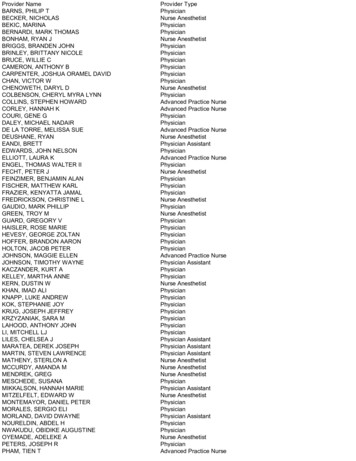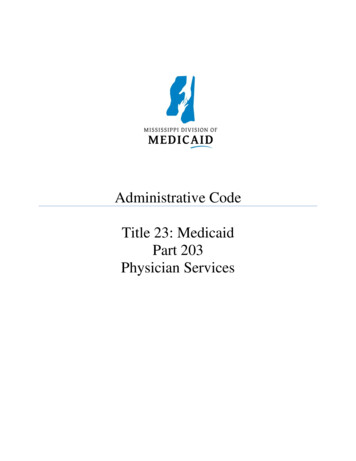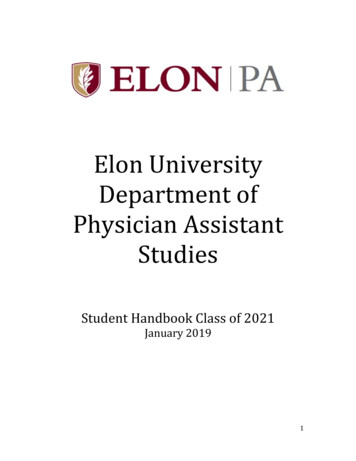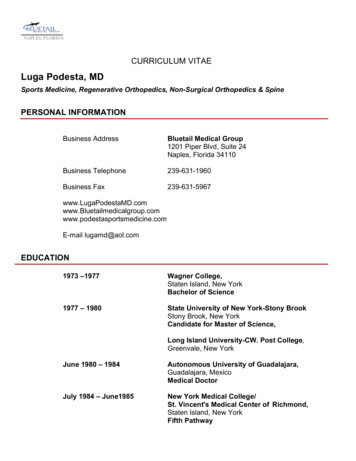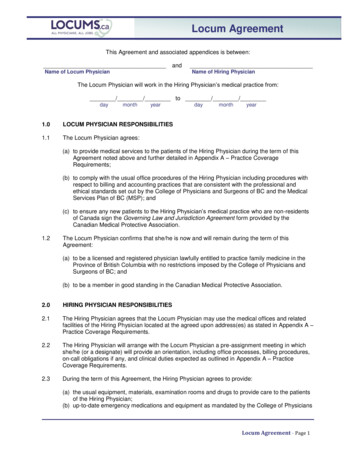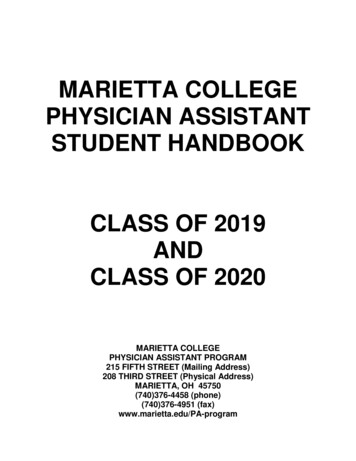
Transcription
2014 Physician Specialty Data BookCenter for Workforce StudiesNovember 2014Association ofAmerican Medical Colleges
2014 Physician Specialty Data BookThis is a publication of the Association of American Medical Colleges. The AAMC serves and leads the academic medicine community toimprove the health of all. www.aamc.org 2014 Association of American Medical Colleges. May be reproduced and distributed with attribution for educational and noncommercialpurposes only.This publication was updated on 6/3/2015.I ii IAssociation of American Medical Colleges 2014
2014 Physician Specialty Data BookAcknowledgmentsWe would like to express our appreciation to our AAMC colleagues for theircollaborative efforts. This publication was produced under the direction ofClese Erikson, Karen Jones, and Monica Whatley, with substantial assistancefrom Sarah Hampton in assembling and reviewing the manuscript.We also owe special thanks to the American Medical Association for makingthe Physician Masterfile available to the AAMC for research purposes, theAAMC Student and Applicant Studies staff for providing data on physicianstraining in graduate medical education, the AAMC Data Warehouse staffwithout whom the data analysis would not be possible, and the AAMCCreative Services team.The Center for Workforce Studies welcomes your comments andsuggestions for future editions of this report. Suggestions by readers led to amethodological change this year for calculations of the people-per-physicianratios for the pediatric and geriatric specialties.Please send comments, suggestions, or questions to:Clese Erikson, Senior DirectorAAMC Center for Workforce Studiescerikson@aamc.orgI iii IAssociation of American Medical Colleges 2014
2014 Physician Specialty Data BookTable of ContentsAcknowledgments. iiiExecutive Summary. 1Key Definitions. 2Commonly Used Acronyms. 3Practice Specialty. 4Section 1: Active Physicians.7Number of Active Physicians in the Largest Specialties by Major Professional Activity, 2013Figure 1.1. 7Table 1.1. 8Number of People per Active Physician by Specialty, 2013Figure 1.2. 9Table 1.2 . 10Number and Percentage of Active Physicians by Sex and Specialty, 2013Figure 1.3. 11Table 1.3. 12Number and Percentage of Active Physicians by Age and Specialty, 2013Figure 1.4 . 13Table 1.4. 14Number and Percentage of Active Physicians with a U.S. Doctor of Medicine (U.S. M.D.) Degreeby Specialty, 2013Figure 1.5. 15Table 1.5 . 16Number and Percentage of Active Physicians with a Doctor of Osteopathic Medicine (D.O.)Degree by Specialty, 2013Figure 1.6. 17Table 1.6 . 18Number and Percentage of Active Physicians Who Are International Medical Graduates (IMGs)by Specialty, 2013Figure 1.7. 19Table 1.7. 20I iv IAssociation of American Medical Colleges 2014
2014 Physician Specialty Data BookNumber and Percentage of Active Physicians Practicing in the State Where They CompletedGraduated Medical Education (GME) by Specialty, 2013Figure 1.8. 21Table 1.8. 22Percent Change in the Number of Active Physicians by Specialty, 2008-2013Figure 1.9. 23Table 1.9. 24Section 2: Residents/Fellows.25Number of First-Year ACGME Residents/Fellows by Specialty, 2013Figure 2.1. 25Table 2.1. 26Number and Percentage of ACGME Residents/Fellows by Sex and Specialty, 2013Figure 2.2. 27Table 2.2. 28Number and Percentage of ACGME Residents/Fellows with a U.S. Doctor of Medicine(U.S. M.D.) Degree by Specialty, August 2007Figure 2.3. 29Table 2.3. 30Number and Percentage of ACGME Residents/Fellows with a Doctor of Osteopathic Medicine(D.O.) Degree by Specialty, 2013Figure 2.4. 31Table 2.4. 32Number and Percentage of ACGME Residents/Fellows Who Are International Medical Graduates(IMGs) by Specialty, 2013Figure 2.5. 33Table 2.5. 24Percent Change in Number of First-Year ACGME Residents/Fellows by Specialty, 2008-2013Figure 2.6. 35Table 2.6. 36IvIAssociation of American Medical Colleges 2014
2014 Physician Specialty Data BookExecutive SummaryThis publication, prepared by the Center for Workforce Studies at the Association of American Medical Colleges(AAMC), provides detailed statistics about active physicians and physicians in training in the specialties with the largestnumber of active physicians (i.e., specialties with more than 2,500 active physicians) in the United States. The 2014Physician Specialty Data Book, updated from the 2012 edition, provides the most current data available about thephysician workforce across specialties in a series of figures and tables.The Data Book is divided into two sections:Section 1: Active Physicians. This section provides data on active U.S. physicians who are in the 41 largest specialtygroups. Data include the number of physicians by specialty; the number of people per active physician by specialty;age, gender, and type of medical degree by specialty; in-state graduate medical education (GME) retention byspecialty; and percent change in the number of active physicians by specialty (2008–2013).Section 2: Residents/Fellows. This section presents data on physicians in residency and fellowship programs for the41 largest specialty groups. Data include the number of residents/fellows by specialty, gender and type of medicaldegree by specialty, and percent change in the number of residents/fellows by specialty (2008–2013).Primary data sources: The American Medical Association (AMA) 2014 Physician Masterfile (data as of December 31, 2013) U.S. Census Bureau population estimates The 2013 AAMC/AMA National GME CensusKey Findings—Active Physicians In 2013, the specialties with the largest numbers of active physicians were the primary care specialties of internalmedicine (111,047), family medicine/general practice (108,917), and pediatrics (56,262). (See Table 1.1.) In 2013, almost one-third (32.6 percent) of the active physician workforce in the United States was female. Percentagesof females in the top specialties ranged from a high of 60.4 percent in pediatrics to a low of 4.6 percent in orthopedicsurgery. (See Table 1.3.) In 2013, 42.6 percent of active physicians in the United States were age 55 or older. Percentages in individualspecialties ranged from 78.9 percent in pulmonary disease to 5.4 percent in internal medicine/pediatrics.(See Table 1.4.) The specialties with the highest percentage of active physicians practicing in the same state where they trained werechild and adolescent psychiatry (57.8 percent), psychiatry (56.3 percent), and family medicine/general practice (56.0percent). The specialties with the lowest percentage practicing in the same state where they trained were thoracicsurgery (31.2 percent), neurological surgery (33.6 percent), and plastic surgery (33.6 percent). (See Table 1.8.) The five-year period from 2008 to 2013 saw remarkable growth in some specialties, particularly interventionalcardiology, which grew 84.7 percent from 1,468 to 2,711. Other specialties decreased in number, including anatomic/clinical pathology (-10.4 percent) and pulmonary disease (-8.8 percent). (See Table 1.9.)I1IAssociation of American Medical Colleges 2014
2014 Physician Specialty Data BookFigureKey Findings—Residents/Fellows In 2013, the specialties with the largest number of first-year Accreditation Council for Graduate Medical Education(ACGME) residents and fellows were the primary care specialties of internal medicine (8,539), family medicine/generalpractice (3,312), and pediatrics (2,789). (See Table 2.1.) In 2013, 46.1 percent of the residents and fellows in ACGME-accredited programs were female. Percentages of femalesin the largest specialties ranged from a high of 82.6 percent in obstetrics and gynecology residencies to a low of 9.5percent in interventional cardiology and vascular and interventional radiology residencies. (See Table 2.2.) In 2013, the largest proportion of residents and fellows in ACGME-accredited programs were U.S. M.D.’s (65.6percent), while international medical graduates (IMGs) comprised 25.9 percent and D.O.’s made up 8.3 percent.(See Tables 2.3, 2.4, and 2.5.) Between 2008 and 2013, vascular and interventional radiology (35.2 percent), pain medicine and pain management(28.7 percent), and critical care medicine (22.9 percent) saw the most growth in the number of first-year ACGMEresidents and fellows. Preventive medicine (-28.6 percent), physical medicine and rehabilitation (-12.6 percent), andanatomic/clinical pathology (-9.5 percent) saw the biggest decreases. (See Table 2.6.)Key DefinitionsActive physicians: Physicians (federal and nonfederal) who are licensed by a state are considered active, provided theyare working at least 20 hours per week. Physicians who are retired, semi-retired, temporarily not in practice, not activefor other reasons, or have not completed their graduate medical education are excluded. Active physicians include thoseworking in direct patient care, administration, medical teaching, research, or other non-patient care activities. Activephysicians include those with a Doctor of Medicine (M.D.) and a Doctor of Osteopathic Medicine (D.O.). The totalnumber of active physicians may differ between tables in this report as a result of missing information in the data file. Forexample, to determine the percentage of active physicians who are female, the total number of active physicians excludespeople whose gender was not reported in the data file.U.S. M.D.: Physicians who received their M.D. degree from a U.S. medical school that is accredited by the LiaisonCommittee on Medical Education (LCME).D.O.: Physicians who received their D.O. degree from a U.S. osteopathic school that is accredited by the AmericanOsteopathic Association Commission on Osteopathic College Accreditation (COCA).First-year residents/fellows: Physicians who are in their first year of a graduate medical education program in theirspecialty are considered first-year residents or fellows. In some cases, the resident or fellow may have had prior GMEtraining in a different specialty.International medical graduate: An individual who graduated from a medical school outside of the United States, PuertoRico, or Canada is considered an international medical graduate. This includes U.S. citizens who completed their medicaleducation outside the United States, Puerto Rico, or Canada. To be eligible for licensure and practice in the United States,all IMGs must be certified by the Educational Commission for Foreign Medical Graduates (ECFMG) and complete aresidency training program in the United States. Graduates of Canadian medical schools are not considered IMGs becausethey do not have to be certified by the ECFMG to enter a residency training program in the United States. Please noteI2IAssociation of American Medical Colleges 2014
2014 Physician Specialty Data Bookthat although graduates of Canadian medical schools who are practicing in the United States are not considered IMGs orU.S. M.D.’s, they are included in the total for active physicians.Commonly Used AcronymsAAMCAssociation of American Medical CollegesACGMEAccreditation Council for Graduate Medical EducationAMAAmerican Medical AssociationD.O.Doctor of Osteopathic MedicineGMEGraduate medical educationIMGInternational medical graduateM.D.Doctor of MedicineI3IAssociation of American Medical Colleges 2014
2014 Physician Specialty Data BookPractice SpecialtyThis report presents data on the specialties with the largest number of active physicians in 2013, which is defined ashaving more than 2,500 active physicians. Specialty designations for active physicians rely on the primary specialtyselected by the physician on the AMA-administered Census of Physicians. Specialty designations for residents and fellowsreflect the ACGME training program in which the physician is training.The AMA Physician Masterfile lists more than 200 specialty categories and there are more than 140 ACGME specialtiesand subspecialties. To give a more comprehensive and informative view of the specialty category, we grouped somerelated specialties together. Because of differences in the specialty designations between the AMA Physician Masterfileand the ACGME, specialty groupings used in this report will sometimes vary for active physicians and trainees asindicated in the table below.Three major changes to the specialty groupings for this year’s report should be noted when comparing to previouseditions. Critical Care Medicine and Pulmonary Disease have been divided into two separate specialty groupings. PainMedicine and Pain Management specialties were combined for the first time and collectively exceed 2,500 physicians. Inaddition, three new specialties grew to exceed 2,500 physicians for the first time since previous reports: InterventionalCardiology, Neuroradiology, and Vascular & Interventional Radiology.AMA Physician MasterfileSpecialties IncludedACGME Specialties andSpecialties IncludedAllergy & ImmunologyAllergy (A)Allergy and Immunology (AI)Immunology (IG)Allergy and ImmunologyAnatomic/Clinical PathologyAnatomic Pathology (ATP)Anatomic/Clinical Pathology (PTH)Chemical Pathology (PCH)Clinical Pathology (CLP)Chemical Pathology (Pathology)Pathology-Anatomic & ClinicalAnesthesiologyAnesthesiology (AN)AnesthesiologyCardiovascular DiseaseCardiovascular Disease (CD)Cardiovascular DiseaseChild & Adolescent PsychiatryChild & Adolescent Psychiatry (CHP)Child & Adolescent Psychiatry (Psychiatry)Pediatrics/Psychiatry/Child & AdolescentPsychiatryCritical Care MedicineCritical Care Medicine (CCM, CCA)Pulmonary Critical Care Medicine(PCC)Critical Care Medicine (Internal Medicine)Critical Care Medicine (Anesthesiology)Pulmonary Disease and Critical CareMedicine (Internal Medicine)DermatologyDermatology (D)DermatologySpecialty GroupingI4IAssociation of American Medical Colleges 2014
2014 Physician Specialty Data BookSpecialty GroupingAMA Physician MasterfileSpecialties IncludedACGME Specialties andSpecialties IncludedEmergency MedicineEmergency Medicine (EM)Emergency MedicineEndocrinology, Diabetes &MetabolismDiabetes (DIA)Endocrinology, Diabetes & MetabolismEndocrinology, Diabetes & Metabolism(END)Family Medicine/GeneralPracticeFamily Medicine (FM, FP)General Practice (GP)Family MedicineGastroenterologyGastroenterology (GE)GastroenterologyGeneral SurgeryGeneral Surgery (GS)General SurgeryGeriatric MedicineGeriatric Medicine (IMG, FPG)Geriatric Medicine (Family Practice)Geriatric Medicine (Internal Medicine)Hematology & OncologyHematology (HEM)Hematology/Oncology (HO)Medical Oncology (ON)Hematology (Internal Medicine)Hematology & Oncology (InternalMedicine)Oncology (Internal Medicine)Infectious DiseaseInfectious Disease (ID)Infectious DiseaseInternal MedicineInternal Medicine (IM)Internal MedicineInternal Medicine/Family PracticeInternal Medicine/ PediatricsInternal Medicine/Pediatrics (MPD)Internal Medicine/PediatricsInterventional CardiologyInterventional Cardiology (IC)Interventional Cardiology (InternalMedicine)Neonatal-Perinatal MedicineNeonatal-Perinatal Medicine (NPM)Neonatal-Perinatal MedicineNephrologyNephrology (NEP)NephrologyNeurological SurgeryNeurological Surgery (NS)Neurological SurgeryNeurologyNeurology (N)NeurologyNeuroradiologyNeuroradiology (RNR)Neuroradiology (Radiology-Diagnostic)Obstetrics & GynecologyGynecology (GYN)Obstetrics (OBS)Obstetrics & Gynecology (OBG)Obstetrics & GynecologyOphthalmologyOphthalmology (OPH)OphthalmologyOrthopedic SurgeryOrthopedic Surgery (ORS)Orthopedic SurgeryOtolaryngologyOtolaryngology (OTO)OtolaryngologyPain Medicine & PainManagementPain Medicine (APM, PMM, PMN)Pain Management (PME, PMP)Pain Medicine (Multidisciplinary)PediatricsPediatrics (PD)PediatricsI5IAssociation of American Medical Colleges 2014
2014 Physician Specialty Data BookSpecialty GroupingAMA Physician MasterfileSpecialties IncludedACGME Specialties andSpecialties IncludedPhysical Medicine &RehabilitationPhysical Medicine & Rehabilitation(PM)Physical Medicine & RehabilitationPlastic SurgeryFacial Plastic Surgery (FPS)Plastic Surgery (PS, PSI)Plastic Surgery Within The Head &Neck (PSH)Plastic SurgeryPlastic Surgery-IntegratedPreventive MedicineAerospace Medicine (AM)General Preventive Medicine (GPM)Occupational Medicine (OM)Public Health & General PreventiveMedicine (PHP)Preventive MedicinePsychiatryAddiction Medicine (ADM)Addiction Psychiatry (ADP)Psychiatry (P)Psychoanalysis (PYA)Psychosomatic Medicine (PYM)Addiction Psychiatry (Psychiatry)PsychiatryPsychosomatic Medicine (Psychiatry)Pulmonary DiseasePulmonary Disease (PUD)Pulmonary Disease (Internal Medicine)Radiation OncologyRadiation Oncology (RO)Radiation OncologyRadiology & DiagnosticRadiologyDiagnostic Radiology (DR)Radiology (R)Radiology-DiagnosticRheumatologyRheumatology (RHU)RheumatologyThoracic SurgeryThoracic Surgery (TS, TSI)Congenital Cardiac Surgery (ThoracicSurgery)Thoracic SurgeryThoracic Surgery-IntegratedUrologyUrology (U)UrologyVascular & InterventionalRadiologyVascular & Interventional Radiology(VIR)Vascular & Interventional Radiology(Radiology-Diagnostic)Vascular SurgeryVascular Surgery (VS, VSI)Vascular Surgery (General Surgery)Vascular Surgery-IntegratedNote: Codes in parentheses represent the AMA Physician Masterfile Self-Designated Practice Specialties/Areas of Practice.I6IAssociation of American Medical Colleges 2014
2014 Physician Specialty Data BookSection 1 – Active PhysiciansFigure 1.1 Specialtieswith the Largest Number of Active Physicians, 2013Figure 1.1 Specialties with the Largest Number of Active Physicians, 2013Internal MedicineFamily Medicine/General PracticePediatricsObstetrics & GynecologyAnesthesiologyPsychiatryEmergency MedicineRadiology & Diagnostic RadiologyGeneral SurgeryCardiovascular DiseaseOrthopedic SurgeryOphthalmologyHematology & OncologyAnatomic/Clinical gyNephrologyOtolaryngologyPhysical Medicine & RehabilitationCritical Care MedicineChild & Adolescent PsychiatryInfectious DiseasePlastic SurgeryPreventive MedicineEndocrinology, Diabetes & MetabolismPulmonary DiseaseRheumatologyNeurological SurgeryNeonatal-Perinatal MedicineGeriatric MedicineRadiation OncologyThoracic SurgeryAllergy & ImmunologyInternal Medicine/PediatricsPain Medicine & Pain ManagementVascular SurgeryNeuroradiologyInterventional CardiologyVascular & Interventional 000 115,000Source: AMA Physician Masterfile (December 2013)I7IAssociation of American Medical Colleges 2014
2014 Physician Specialty Data BookSection 1 – Active PhysiciansTable 1.1NumberPhysiciansof Physiciansthe LargestLargest SpecialtiesbybyMajorProfessionalActivity,2013Table 1.1 Numberof 2013SpecialtyAll SpecialtiesTotal ActivePhysiciansPatient 718Allergy & ImmunologyAnatomic/Clinical cular ld & Adolescent Psychiatry8,8327,82686112808DermatologyCritical Care Medicine11,36310,84174101347Emergency 108,917101,7641,6082615,284Endocrinology, Diabetes & MetabolismFamily Medicine/General al Surgery25,18722,2312261472,583Geriatric MedicineHematology & OncologyInfectious DiseaseInternal al Medicine/Pediatrics4,3964,0144329310Interventional Cardiology2,7112,52084179Neonatal-Perinatal 9612281Neurological 82186311Obstetrics & 1717,382105134696Orthopedic ogyNeuroradiologyOtolaryngologyPain Medicine & Pain 57003,480Physical Medicine & Rehabilitation8,9068,2014047618Plastic Surgery6,9426,7103619177Preventive 41Pulmonary Disease5,7265,039151320216Radiation eumatology5,3574,65680273348Thoracic Surgery4,5214,2293246214PsychiatryRadiology & Diagnostic RadiologyUrology9,7719,3536339316Vascular & Interventional Radiology2,5812,31595252Vascular Surgery3,1302,9232816252Source: AMA Physician Masterfile (December 2013)1Other includes physicians whose self-designated major professional activity was "Administration," "Not Classified,"or "Other."I8IAssociation of American Medical Colleges 2014
2014 Physician Specialty Data BookSection 1 – Active PhysiciansFigure 1.2 Number of People per Active Physician by Specialty, 2013Figure 1.2 Number of People per Active Physician by Specialty, 2013Vascular & Interventional RadiologyInterventional CardiologyNeuroradiologyVascular SurgeryPain Medicine & Pain ManagementInternal Medicine/PediatricsAllergy & ImmunologyThoracic SurgeryRadiation OncologyNeonatal-Perinatal MedicineNeurological SurgeryRheumatologyPulmonary DiseaseEndocrinology, Diabetes & MetabolismPreventive MedicinePlastic SurgeryInfectious DiseaseCritical Care MedicinePhysical Medicine & tologyNeurologyGastroenterologyAnatomic/Clinical PathologyHematology & OncologyOphthalmologyOrthopedic SurgeryCardiovascular DiseaseGeneral SurgeryRadiology & Diagnostic RadiologyChild & Adolescent PsychiatryGeriatric MedicineEmergency MedicinePsychiatryAnesthesiologyObstetrics & GynecologyFamily Medicine/General PracticeInternal 120,000140,000Source: AMA Physician Masterfile (December 2013) and Annual Estimates of the Resident Population by Single Year of Age andSex for the United States: April 1, 2010 to July 1, 2013 from the U.S. Census Bureau, Population Division Release Date: June 2014Note: The population under age 21 was used in calculations for Pediatrics and Child and Adolescent Psychiatry.The population over age 64 was used in calculations for Geriatric Medicine.I9IAssociation of American Medical Colleges 2014
2014 Physician Specialty Data BookSection 1 – Active PhysiciansTable per1.2 NumberPeople per byActivePhysician2013by Specialty, 2013Table 1.2 Number of PeopleActiveofPhysicianSpecialty,SpecialtyAll SpecialtiesTotal ActivePhysiciansPeople PerPhysician829,9623814,50470,188Anatomic/Clinical iovascular Disease22,02014,356Child & Adolescent Psychiatry8,23711,080Critical Care y Medicine37,2418,4896,51948,493Allergy & ImmunologyEndocrinology, Diabetes & MetabolismFamily Medicine/General Practice
Association of American Medical Colleges 2014 2014 Physician Specialty Data Book I 3 I that although graduates of Canadian medical schools who are practicing in the United States are not considered IMGs or U.S. M.D.'s, they are included in the total for active physicians. Commonly Used Acronyms AAMC Association of American Medical Colleges

